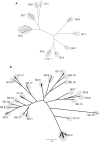Proposal for a unified norovirus nomenclature and genotyping
- PMID: 23615870
- PMCID: PMC5570552
- DOI: 10.1007/s00705-013-1708-5
Proposal for a unified norovirus nomenclature and genotyping
Abstract
Noroviruses belong to a genus of genetically diverse viruses within the family Caliciviridae and cause acute gastroenteritis in humans and animals. They are subdivided into genogroups, each of which further segregates into genotypes. Until recently, a new genotype was based on a defined pairwise distance cutoff of complete VP1 sequences, but with the increasing number of available norovirus sequences, this cutoff is no longer accurate, and sequences in the public database have been misclassified. In this paper, we demonstrate that the pairwise distance cutoff method can no longer be used and outline a phylogenetic approach to classify noroviruses. Furthermore, we propose a dual nomenclature using both ORF1 and VP1 sequences, as recombination is common and recognizing recombinant viruses may be relevant. With the continuing emergence of new norovirus lineages, we propose to coordinate nomenclature of new norovirus genotypes through an international norovirus working group.
Figures



References
-
- Ando T, Noel JS, Fankhauser RL. Genetic classification of “Norwalk-like viruses. J Infect Dis. 2000;181(Suppl 2):S336–S348. - PubMed
MeSH terms
Grants and funding
LinkOut - more resources
Full Text Sources
Other Literature Sources
Medical

